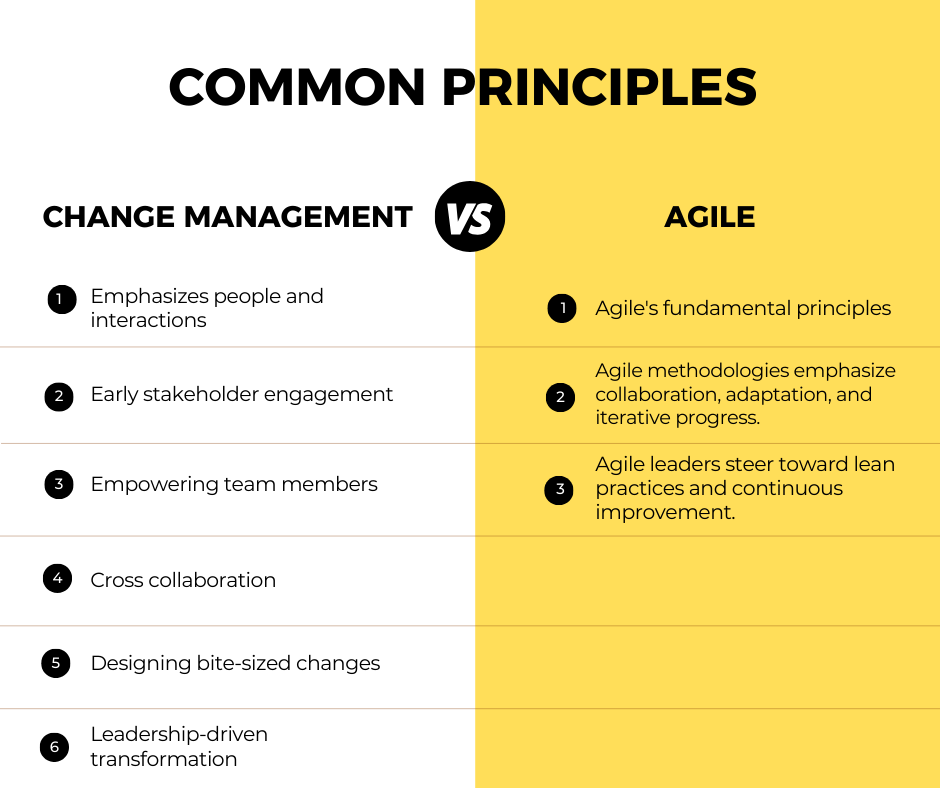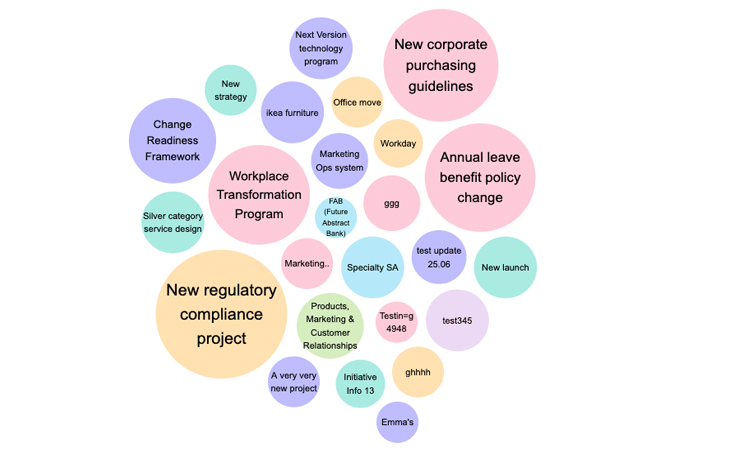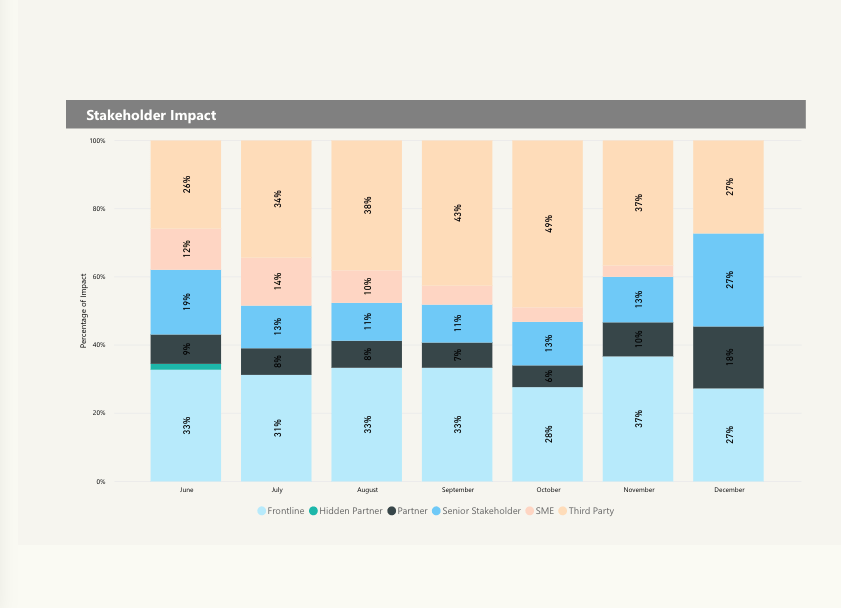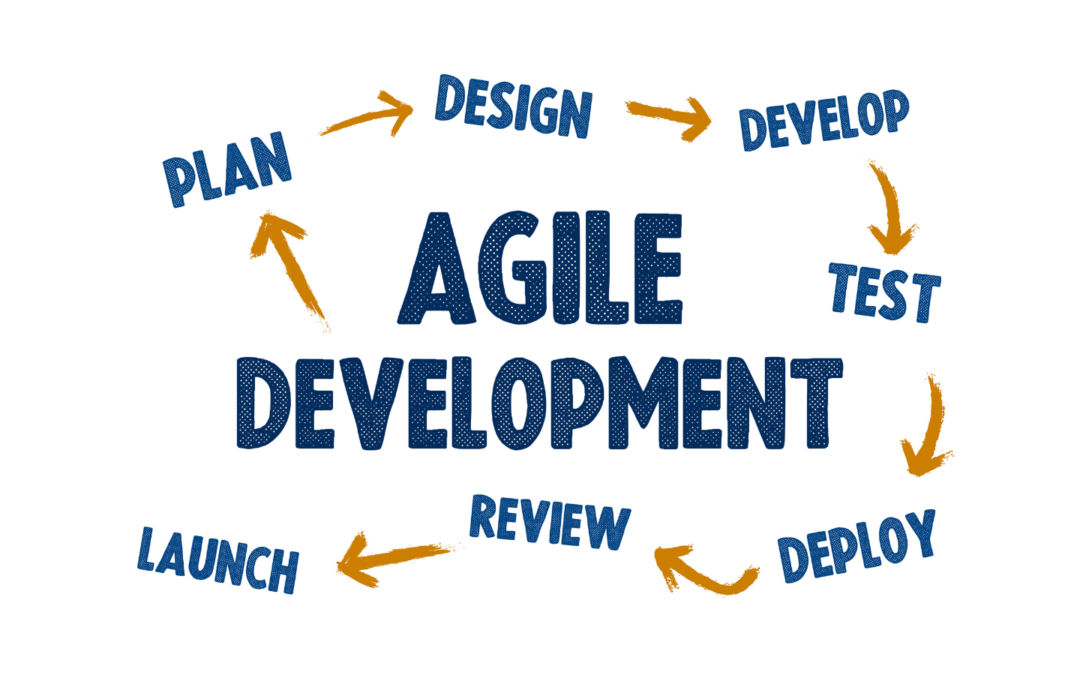
How to land multiple change initiatives – ACMP presentation slides
How to land multiple change initiatives - ACMP presentation slides





These are slides from the presentation to the ACMP (Association of Change Management Professionals) Conference in Las Vegas.
The change analogy was used to help change professionals explain the various components and facets of managing a portfolio of change initiatives.

In the ever-evolving landscape of project management and software development, Agile has transcended its origins and become a versatile approach applied not only in software development but also in project and operations management. As Agile gains popularity, change practitioners are increasingly aligning their strategies to support Agile environments. This article explores the fundamental principles of Agile and how they dovetail with change management, highlighting the valuable lessons we can draw from Agile’s evolution.
Agile’s Expansion Beyond Software Development
Agile, initially conceived for software development, has expanded its horizons to encompass project management and operations. The principles that underpin Agile, outlined in the Agile Manifesto, have become a guiding light for many across various industries. With methodologies like Scrum, Kanban, and Refactoring, Agile can be applied at different levels, from project teams to program and portfolio management.
Having personally gone through the Scaled Agile certification process, I was struck by how many fundamental change management principles are deeply embedded within Agile. In my multi-day training course, case studies, and examination, I realized that many concepts that are considered common sense in change management are sometimes perceived as ‘new’ for technical leads or project managers in an Agile context. Agile inherently incorporates principles that change managers have advocated for a long time.

1. Individual Interactions Over Processes and Tools
In technology-driven environments, technical professionals are highly regarded for their problem-solving skills. The typical response to issues or improvement opportunities is to seek technical solutions. However, the Agile Manifesto focuses on people and interactions. It stresses that teams perform at their best when they maintain constant interaction to ensure effective communication, clarity, and understanding of the work at hand. For instance, a study by McKinsey found that projects with strong team interactions deliver on their objectives 95% of the time, while those lacking strong collaboration only succeed 50% of the time. This principle resonates strongly with change managers, who have consistently advocated for a focus on people and behaviors as central to change management success.
2. Early Involvement of Stakeholders
Agile projects move swiftly, making it crucial to involve stakeholders early in the project development lifecycle. Early engagement ensures clear alignment, fosters relationships among team members, and helps draw out assumptions and set expectations. For example, a survey conducted by Prosci revealed that projects involving early stakeholder engagement had a 74% success rate, compared to only 31% for projects that did not engage stakeholders early. This aligns with change management practices, which emphasize engaging stakeholders early to secure buy-in and alignment. Beyond formal communication, it encourages open dialogue and the testing of assumptions for early clarity across the project team.
3. Empowering Team Members
Traditionally, project managers held the reins in decision-making across all aspects of a project, including solution features and task allocation. Agile challenges this command-and-control model by empowering teams to make these decisions. Effective Agile teams are often self-organized, with project managers transitioning to coaching and enabling roles. For example, a study by Gallup found that empowered teams have 21% higher productivity and 28% less absenteeism. This empowerment aligns with the core principles of change management, which emphasize team dynamics and employee empowerment as essential for team development and engagement.
4. Cross Collaboration
Agile projects thrive on the diverse collaboration of team members from different disciplines and departments. This diversity of thought leads to more innovative ideas, as it brings different perspectives to problem-solving. For example, a report by Deloitte found that organizations with cross-functional teams are 1.7 times more likely to be leaders in innovation. Agile practices, such as cross-team daily stand-ups, release planning, and retrospectives, require different disciplines to come together and contribute to the project. Change management has long focused on breaking down silos and promoting collaborative behaviors, using workshops, communication, campaigns, and leadership influence to foster the right culture and behaviors for successful outcomes.
5. Designing Bite-Sized Changes
One of Agile’s fundamental principles is the idea that, instead of launching large, all-encompassing changes, it’s better to break them down into smaller, iterative pieces. This approach allows for continuous learning and improvement and mitigates the risk of major failures. Change management aligns with this principle by assessing the change capability and capacity of impacted audience groups. For instance, a case study by Prosci showed that an organization that implemented small, incremental changes had a 20% higher user adoption rate compared to organizations that introduced major changes all at once. Smaller, bite-sized changes are easier for users to accept, preventing change fatigue and disruptions to business as usual.
6. Leadership
Agile explicitly acknowledges that organizational managers and leaders bear the ultimate responsibility for the adoption, success, and continuous improvement of lean practices. Leaders must steer the organization towards agile and lean behaviors, role-model the right behaviors, create an environment conducive to team success, and ensure continuous team learning. Leadership plays a central role in change management, driving transformation, and cannot be delegated.
As we’ve explored the evolving landscape of project management and software development, it’s clear that Agile is no longer confined to its origins. It has become a versatile approach, expanding beyond software development to encompass project and operations management. With Agile’s growing popularity, change practitioners are increasingly aligning their strategies to support Agile environments. In this article, we’ve delved into the fundamental principles of Agile and how they seamlessly integrate with change management. Now, let’s take a closer look at real-world best practices with actionable advice and examples that illustrate the power of combining Agile and change management in practical scenarios.
What’s more, we provide actionable advice that you can apply directly to your projects. Whether you’re leading a software development team or managing a complex change initiative, the best practices we showcase can be tailored to suit your specific needs. From effective stakeholder engagement techniques to strategies for empowering your teams, you’ll find practical steps to ensure your projects thrive. For example, implementing daily stand-up meetings for cross-functional teams can significantly enhance collaboration and idea exchange within your projects.
By incorporating these best practices, organizations can harness the full potential of Agile and change management to adapt, innovate, and achieve exceptional results. With expert guidance and empirical evidence of successful benchmarks, you can confidently implement these principles in your projects, ensuring success in even the most complex and dynamic environments.
The synergy between Agile and change management is undeniable. Agile principles, which emphasize people, collaboration, empowerment, and adaptability, align remarkably well with the foundational principles of change management. Whether transitioning from a technical background to Agile or integrating Agile into change management practices, it’s essential to recognize that Agile is more about mindset and principles than specific technicalities. By embracing these shared principles, change management and Agile become a harmonious partnership, working together to drive successful transformations and project outcomes.
To learn more about how The Change Compass can help you bridge the gap between Agile and change management, book a weekly demo with us.

The change management profession has grown by leaps and bounds. This is proportional to the speed and magnitude of change that organizations are currently going through. To manage this complexity, a lot of large organizations have created ‘enterprise change management’ or ‘portfolio change management roles’ to tackle this.
In the same way that there are portfolio managers to manage a suite of projects, organizations are realizing that portfolio change managers may be needed to effectively drive change success. Like the portfolio manager, the portfolio change manager also manages a particular group of initiatives. This grouping is usually done based on the size of change initiatives and or business groups. There are also examples of groupings by ‘value stream’ or program clusters. For example, a portfolio change manager may be in charge of all technology projects and supporting the technology group, whilst another portfolio change manager support sales and marketing initiatives or back office groups.
To download our infographic on how to manage a change portfolio click here.
As a new field, there is not a lot of ‘how-do’ guides for the new portfolio change manager. A quick scan of the internet found very little substance in term of all facets of the work of the portfolio change manager. This guide is written to fill this gap and to help those starting out in this role or decisions makers considering creating such roles to build change effectiveness.
To effectively manage the change initiatives within the portfolio, the change portfolio manager needs to proactively work on the below 7 key areas:

Marketing group working on presentation. Scrum meeting, teamwork, task list. Business concept. Vector illustration can be used for presentation slides, landing pages, and posters
Defining the service you are offering to the organization is one of the most critical activities. To do this, you need to conduct an assessment of where the organization is at and its various needs for change management services. Key questions to ask include:
After understanding the needs of the organizations and where the organization would like to head to in its change management objectives, one can then define services required.
Common services offered by a portfolio change manager or portfolio change management function includes:
After defining the service provision, the next activity to focus on is how these services will be delivered. This depends on organizational needs, resources available and the skills of available practitioners in the group. Examples of service delivery options include:

Depending on the services offered and business requirements, the Change team composition may look different. For example, for some organizations where the need is more on coaching and advisory services, fewer but more senior Change practitioners may be needed. On the other hand, for another organization where the focus is more on project delivery, the focus may be placed on a number of Change Managers and Change Analysts to support initiative delivery.
Key decision should be placed on achieving a balance of permanent headcounts versus contractors. Permanent in-house practitioners will have a deeper understanding of organizational needs and how the organization works. Contractor staffing is beneficial so as to allow the flexing or resources up or down across initiatives. Organizations that only rely on Change contractors usually fail to significantly build business change capability and maturity over time. This is because over time Change Management is seen by the business to be an activity done by contractor practitioners, thus not diluting their accountability. The group may also leverage external providers as needed for specialist skills or to offset any requirement peaks.
Forecasting demand is an important activity to get right so as not to set stakeholder expectations that cannot be fulfilled. Demand forecasting for Change services involves the following:
To support purely agile projects, the Change group needs to define change deliverables throughout each phase of the initiative delivery cycle. From then, determine the resource requirement. Foundational change management work will still be applicable within an agile environment, including conducting change impact assessment, planning for change, measuring readiness for change and building business transition capability.

At the lower end of the maturity curve, the Portfolio Change Manager may spend most of the time scoping for change resources, managing delivery, managing change professionals and liaising with key stakeholders. These are absolutely necessary activities. However, to really move up the strategic ladder the Portfolio Change Manager also needs to be able to influence the planning of the initiative portfolio versus only focusing on the delivery end of the curve.
In most organizations the PMO is tasked with managing the initiative investment and planning process. Most would refer to strategic objectives and goals and through this define the overall slate of initiatives for the coming year. Key data used include financial targets, initiative benefits, initiative resourcing and investment cost, and timing. The Portfolio Change Manager is often not involved in this process at all, or best, invited for comments around ‘change saturation’ or ‘change collision’ that are not substantiated by hard data.
To be at the decision table in planning effectively for change, the Portfolio Change Manager needs to be equipped with data to aid insight and decision making. How? By building an integrated view of change impacts. Currently, a lot of organizations still use a series of disjointed spreadsheets to try and articulate the change impacts across initiatives. The problem with this is is that:
To address this problem, The Change Compass is a digital tool designed to make it easier for the Change Portfolio Manager or the PMO to piece together all the change impacts across change initiatives. Each initiative owner inputs change impact data and the system prompts the user to update the data. The interface is intuitive and draws out the impacts step by step. The Portfolio Change Manager and other managers are able to instantly generate various reports. In a nutshell it helps the organization to manage the ‘air traffic control’ of landing initiatives. Moreover, it enables:
To check out our article on how to better manage a change portfolio click here.

The Portfolio Change Manager should work with the PMO and senior managers to ensure the appropriate governance and routines are designed and set up. To do this, analyse the business requirements in connecting different stakeholder groups to ensure alignment, buy-in, visibility and ownership of the initiative slate. Portfolio change governance bodies should include attendance by PMO, senior business leaders and the Portfolio Change Manager should focus on reporting and tracking on business impacts, business readiness, delivery milestones and delivery risk identification and mitigation.
Typical routines that the Portfolio Change Manager should assist in establishing include:
Whilst change impact data is critical to support the work of change governance bodies, there are other initiative-level metrics that the Portfolio Change Manager needs to be focused on in tracking and reporting. These include:

Currently, there is a significant trend of moving towards agile project methodology in most large organizations. This means that there are less focus and reliance on documentation, long planning cycles but more on effective conversations, stakeholder alignment, and constant iteration and learning. On top of this, a lot of organization are also moving toward scaled agile methodology (agile at organizational level vs. within an initiative). The Portfolio Change Manager needs to define key change deliverables and work approaches that suit his/her organization (acknowledging that agile may not suit every organization or every initiative).
Having effective change tools means that the business can self-help and the change practitioner can better coach and develop the business. For the Portfolio Change Manager useful tools may include:
The Portfolio Change Manager is tasked with a complex set of tasks in driving a set of change initiatives for the organization. He/she needs to have the people skills to influence a range of stakeholders to transition to the new state. In addition, the person needs to possess business acumen and analytical skills to support the PMO and senior managers to make the right decisions to drive change across initiatives. Whilst not exhaustive, this guide calls out key critical areas undertaken by the Portfolio Change Manager. To be successful going forward, the Portfolio Change Manager needs to constantly deliver value and provide insight through leveraging digital tools and hard data to be at the decision-making table.
Check out our Ultimate guide to agile for change managers.
———————————————–
If you’ve found this article useful please like this on Linkedin
If you’ve found this article interesting, please ‘like’ and share this with your connections.


Please also check out our ultimate guide to change portfolio management.

A typical scenario for a lot of program meetings goes something like this. The program spends the bulk of the time discussing program cost, delivery progress, technical risks and resourcing challenges. And when it comes to Change Management reporting, we are often left with a few anecdotes from stakeholder interviews, and often the only real quantitative reporting comes in the forms of training completion, readiness surveys, and email communications hit rates.
One wonders why Change Management is often glossed over as fluffy and soft vs. strategic and quantitative. Even for those who intuitively believe that managing change ought to be important, most lack quantitative data that demonstrate clearly how change progress directly impacts business outcomes.
How does a business manager, program or a change practitioner demonstrate the true strategic value of tracking change initiatives in order to highlight any risks and achievements? In particular with a group of initiatives.
Here are a few ways in which change impacts may be captured and reported in a quantitative way to support strategic decision making, starting with a birds-eye-view and sequentially drill down deeper to understand the scenario to aid strategic decisions:
One of the most profound ways in which change progress may be reported at a strategic level is by the extent to which initiative change impacts are shaping customer experiences. How are customer experiences shaped as a result of the suite of changes taking place?
Do initiatives result in a positive or negative impact on customer experience? E.g. does it improve or worsen a service delivery speed, functionality, quality, etc. Legislative initiatives for example may result in negative experiences depending on the nature of the change.
Is there too much change going on at the same time?
Does the customer give a damn about the change?
A good high-level view of various change impact data for an executive dashboard may include:
Initiative quantity and type (technology, product, policy, etc.) throughout the calendar year
Impact level and type (go-live, training, customer, etc.)
At-a-glance pie charts and bar graphs are ideal for summarizing multiple axes of data within a 1-pager
A good heatmap can be one of the most visually memorable reports on change impact with options to drill down into colour-coded divisional and sub-divisional impacts across the timeline indicating both the number of initiatives as well as the levels of impact.
A detailed initiative schedule is helpful as we start to drill down to analyze which initiatives are contributing to business and delivery risks. Data may include initiative names, impact level, impact type, and impact dates across the calendar year. One starts to get a detailed understanding of which initiatives are high impact, contributing to change fatigue or could be better communicated and in synchronisation with other initiatives to reduce complexity for the audience.
After we have a clear understanding of the initiatives that we need to work on aligning to improve the overall execution and delivery effectiveness we then move to clarify the details of each initiative. At this level, the reporting contains a description of the initiative, contact persons, delivery timeline and business impact data. The report, therefore, should contain sufficient details to allow very actionable steps to connect, discuss, and plan for change alignment between initiative, portfolio and business owners.
To read more about change analytics follow these links:
Top 7 challenges faced by change managers in generating insight from change data

Instead of a myriad of project-based governance bodies, establish a divisional business body focused on managing change impacts on people and customers. This may be embedded into an existing monthly divisional leadership meeting. In this governance meeting, the focus is on:
This is not to say that project-based governance is not required. Business involvement is critical in project governance. However, a key focus should be placed on understanding the overall picture first and what the business is going to go through. From this clarity, it will then be easier to see how each initiative fits into the overall picture and if there are rollout considerations.
With clear change impact data, discussions will also be more swift, focused on more strategic conversations vs. gut feel and individual preferences. In this way, change is also being positioned as much more rigorous, data-driven, and scientific, versus fluffy, undefined, or worse, unimportant.
One way to improve change capability in an organization is to focus operations on change and implementation, versus viewing change management as a separate piece of work done by Change Managers. This involves:
Check out our infographic on how to better manage a change portfolio.
One of the core problems faced by companies is how to quantify change impacts and make them more tangible, easier to visualize, measure and manage.
Change impacts may be quantified in the following way:
From the information provided, the analysis may then be undertaken, looking at the loading of change, whether there is any potential change clash from a timing perspective, whether there is behavior consistency across initiatives rolled out, and whether the initiatives overall are driving the organization’s strategy forward.
Moreover, with sufficient historical data, the company may then be able to correlate the impact of the ‘amount’ of change on business performance. From this, the change impact data may then be used to even ‘predict’ future business performance. Such is the power of quantifying change impact.
A significant number of companies are now jumping on the bandwagon of focusing on customer experience. This is because other value levers such as cost and efficiency are almost maxed out and there are few additional efficiencies that can be achieved there.
To truly manage customer experience one needs to start by understanding the total picture of what the company is planning to change for a particular group of customers. This includes:
After collecting these data, a customer’s experience may then be mapped out from the perspective of change impacts on their experience. Is there a number of legislative initiatives that will create a negative customer experience? Is there too much change planned? What would be the optimal ‘change loading’ for customers? The customer impact data enables valuable discussions and decisions
Check out our ultimate guide to change portfolio management.
For smaller organizations managing change initiatives, spreadsheets may suffice. However, for large organizations managing a large portfolio of changes, spreadsheets may not be sufficient.
Technology solutions now enable both drivers and receivers of the change to access impact information any time and anywhere. This promotes collaboration and effective conversations. Companies will not need to rely on an army of analysts to constantly collect and verify the data, since the data is coming straight from ‘the source’. Reporting efforts are also optmized by having standard, automated reporting, generated at any time required.
Technology solutions are also great for agile-focused organizations where there is always a series of constant and iterative changes, and where change impact information could change rapidly from week to week. Access to accurate and timely data is even more critical.
Stakeholders across the company are also able to see, in real-time, the change impacts being planned. From this, meaningful conversations may be had in terms of the level and nature of change impacts from different stakeholder perspectives. For example, does the business share the same agreement of change impact as the program? This creates transparency and shared accountability in the ownership of change outcomes.
In implementing a data-based model of managing change impacts organizations will experience an uplift in change capability. How?
After a division reviews the feedback from stakeholders after initiatives get rolled out, referencing indicated ‘amount’ of change planned, this reference ‘amount’ then becomes a yardstick for answering ‘how much is too much change’.
Moreover, with regular routines and reviews over time, the yardstick of change loading can then aid future decision making on 1) the optimal change impact loading for the business, 2) readiness activities required to better manage across changes, 3) prioritization required, and 4) potential for synchronization across initiatives (e.g. communication or training efforts).
In this way, the business division learns to determine how best to utilize change impact data to prepare for changes, avoid change fatigue, and to maximize adoption. The outcome of this is testing with ‘tactics’ of managing the changing load, and improved business performance. With open data sharing, there is also an opportunity for cross-divisional learning to pick up tips from each other on how to manage multiple changes and still deliver operational performance.
Click here to download our infographic on How to Better Manage a Change Portfolio.

Agile is all the rage at the moment in driving change and transformation. Many call out the importance of stakeholder management, communicating regularly, ensuring strong sponsorship, and clarity of business requirements. Others emphasize the need to have continual people interactions versus documentation and processes. For the uninitiated all of these seem to make sense, but yet not that different compared to using other methodologies in other projects. Agile methodologies have emerged as the catalysts for change and transformation. Anchored by principles such as stakeholder engagement, transparent communication, and robust sponsorship, Agile’s true essence lies in its unique approach – the rapid release of incremental changes, fostering a culture of continual learning and adaptability.
One of the key tenets of agile involves releasing a series of smaller changes rapidly, learning and adjusting from each release, rather than spending a longer time to work on a much bigger release that may or may not be successful.
However, releasing a series of changes can be unsettling, disruptive, and hard to keep up for employees. This is especially the case for larger programs when the timeline could go for more than 1 year. Combining several programs, you can imagine the unsettling rather of these changes on employees and the business.
How do we resolve this? The key is to provide a strong picture of the end state and how things will look like and set the expectation that there will be a series of changes, providing examples of these as well as explaining why this is an effective way to drive change. Yes, We may not know exactly the details of the end state, but the business should be clear in the overall outcomes and key works to get there.
To do this effectively we need to be able to connect the dots and tell the story of the journey of change and how the different changes connect to lead us to the end state. Sounds simple? Yet lots of companies are not able to reach this outcome due to a big pipeline of changes.
Agile in Software Development: Consider a software development project embracing Agile principles. Instead of the traditional monolithic release after months of development, Agile allows teams to deliver functional components regularly. Users gain hands-on experience early, providing invaluable feedback for immediate adjustments.
Navigating Business Transformation: In a complex business transformation, Agile’s iterative approach proves invaluable. Imagine a company implementing a new customer relationship management (CRM) system. Agile permits incremental updates based on user feedback, ensuring the CRM aligns seamlessly with evolving business needs.
Strategic Resource Allocation: A company grappling with a pipeline of diverse changes faces challenges in maintaining clarity. Digital tools, like ‘The Change Compass,’ offer a panoramic view, enabling leaders to visualize the interconnectedness of initiatives. This facilitates strategic decision-making and precise resource allocation.
Employee-Centric Transformations: Consider an organization rolling out changes to internal workflows. Agile, supported by digital tools, empowers leaders to communicate phased changes effectively. This ensures employees not only understand the bigger picture but also feel more engaged in the transformation process.
The solution? Use digital means to connect the dots and not rely on personal interpretation. Use a digital tool to examine what is coming down the pipeline, and therefore create meaning and better prioritize initiatives to move the business forward. By seamlessly weaving Agile methodologies into their fabric and harnessing the power of tools such as ‘The Change Compass,’ organizations adeptly steer through the ever-evolving landscape of perpetual change. Serving as a strategic guide, ‘The Change Compass’ leverages analytics and machine learning to streamline change orchestration, prioritize initiatives, and guide organizations with precision and confidence toward their transformation targets. This approach cultivates a work environment characterized by transparency, adaptability, and active engagement. As a result, the journey toward the end state transforms into a seamlessly connected narrative of continual progress and sustainable growth.

“A recent survey by the Change Management Institute (Employment Study) in 2015 indicated that 77% of all Change Management roles in Australia are contract roles. Are you surprised by this figure? Would you have expected this figure to be lower or higher? And why is it that most Change roles here are contract roles?
Many of you will state that obviously Change roles are there to help the company design and implement a change initiative and since changes are time-bound, it makes sense to employ a contract Change expert only for this duration. Others will call out that the flip side to this approach is that change capability comes and goes and the organization is not really able to build its inherent ability to.
Let’s look at how some of the most admired companies approach this. For those companies that are consistently listed the most admired global companies such as Intel, Apple, Microsoft, Johnson & Johnson, etc., the approach is very different. For these organisations there is not a lot of ongoing contract Change roles. Instead, the leadership and operations uptake the responsibilities of driving change. And yes, this includes project work where folks work on change impact assessments and implementation planning.
Take for example, at Intel the company typically redeploys its talent regionally and globally and where needed specialists may be brought in to lead or support change initiatives such as a new system implementation or new strategy. On the ground, operations leads are identified within the business and are expected to drive, support, communicate and monitor the progress of the initiative. Change capability is built into ongoing management and team development, though there are also internal training courses focused specifically on Change. This model drives significant business ownership and avoids a lot of the buck passing and challenges of reaching full benefit realization compared to the mainly contractor model.
A key requirement of this model is that the business needs to be very clear with its key focus areas in driving change and not be inundated by too many initiatives. The leadership and operational leads constantly review a dashboard of initiatives and are clear with their impacts as well as the prioritization of the initiatives.
I’m not advocating that companies do not need Change contractors at all but we need to be clear what our operating model is to build change capability. Are we only seeking a pair of hands as needed to do project work? Or do we have a more strategic approach to design change know-how within the organization? What has been your experience in designing a Change Management model that builds inherent capability?
The Change Compass is an industry-first change management tool that helps organisations manage change impacts through data vs opinions.

Effective change management enhances organizational change management agility, boosts employee engagement, maximises change efforts and minimizes resistance to change. This can apply to digital transformations or other types of significant changes. It fosters a culture of adaptability to new business processes, ensuring that teams can navigate transitions smoothly. Ultimately, it leads to improved productivity, better communication, and higher overall satisfaction among employees and stakeholders alike, driving long-term success.
In the corporate world, most approaches in defining the business value of change involve hard benefits such as revenue, cost, and time. For example, increased revenue per customer, reduced people costs, and improvement in processing time. Yes, there are non-financial benefits such as capability improvement and strategic alignment. However, in practice, most tend to focus more on hard benefits that are more tangible and easier to track.
The problem is that benefits are usually defined in a top-down, linear way and have not taken into account the environment that determines the benefits. For example, a Strategy department defines the need to cut people costs by 10% and therefore the analysis will subsequently focus on headcount reduction or pay and benefits reduction. Finance will therefore work with HR and the business to start defining which headcounts to cut and any opportunities to reduce pay and benefits. A list is then gathered to report on potential cost savings in dollar terms.

On paper, everything looks fine, but without actually involving those managers in business and understanding the environment in which the costs will be saved it is hard to determine the actual benefits. How much influence do these roles have on the organization from lateral networking and influencing perspective? Can any of these roles be critical in implementing the change process? What are the potential impacts in service delivery resulting from these cuts? The learning here is that top-down analysis of benefits can often only be treated as high level and we need to work within the organization to find out the real benefits.
In a previous role, an IT department wanted to reduce the $25 per call for employees to change their passwords. When I started finding out more about the experience and the process for an employee to change passwords the discovery I made was quite shocking from an employee morale perspective. The $25 was negligible compared to the real cost. For example, my team member Barbra just returned from maternity leave and had forgotten her login password. She rang the Helpdesk 4 times to try and retrieve her password but was unsuccessful for some reason. Barbara became increasingly irate. We’ve heard her screaming at the phone, taking breaks to calm down, and talking to others to express her frustration. For days she was not able to log on. For Barbara’s case, the company has lost the equivalent of 3 days in productivity to the tune of $2500. We’ve also found other similar cases.
Change management professionals can do this by observing the environment for those impacted by the change initiative, or the employee or customer experience. Utilise human-centred approaches in observing the employee or the customer and how the initiatives may impact their lives. These include observation of key stakeholders as a part of the overall change program, seeing the whole picture by putting yourself into their shoes, identifying the impacts on various people and processes, and if needed interviewing them after observation to find out more. What else will be happening in their worlds other than the change initiative in concern? Will there be risks of overlaps or time conflicts for different initiatives?
Change managers can tally various sources of benefits observed. Who are the people potentially impacted by the change initiative? What processes and systems are impacted by the new technology or new software? Therefore, what are the sources of potential benefits in terms of time, cost, or revenue? Have a chat with your business leaders to confirm on these.
As a part of the change management practices, test at a smaller scale initial change implementation approaches on the selected target audience and observe the effects of change and resulting benefits. Take an proactive approach to experiment and tweak these approaches before larger-scale implementation.
Effective change management enhances organizational agility, improves employee engagement, and boosts productivity. It minimizes resistance to change by fostering clear communication and support, leading to smoother transitions and minimise unrealized benefits. Ultimately, these benefits contribute to sustained growth and a competitive edge in today’s rapidly evolving business landscape.
To read more about calculating the financial benefit of managing a change portfolio visit our article here.